In this article I will talk about a very exciting blockchain-based project that has really caught my attention for their vision, execution and potential. The project is called Dadi and it will provide a vast array of web/cloud computing services to anyone looking to build a digital product. The upcoming Dadi ICO will be also covered.
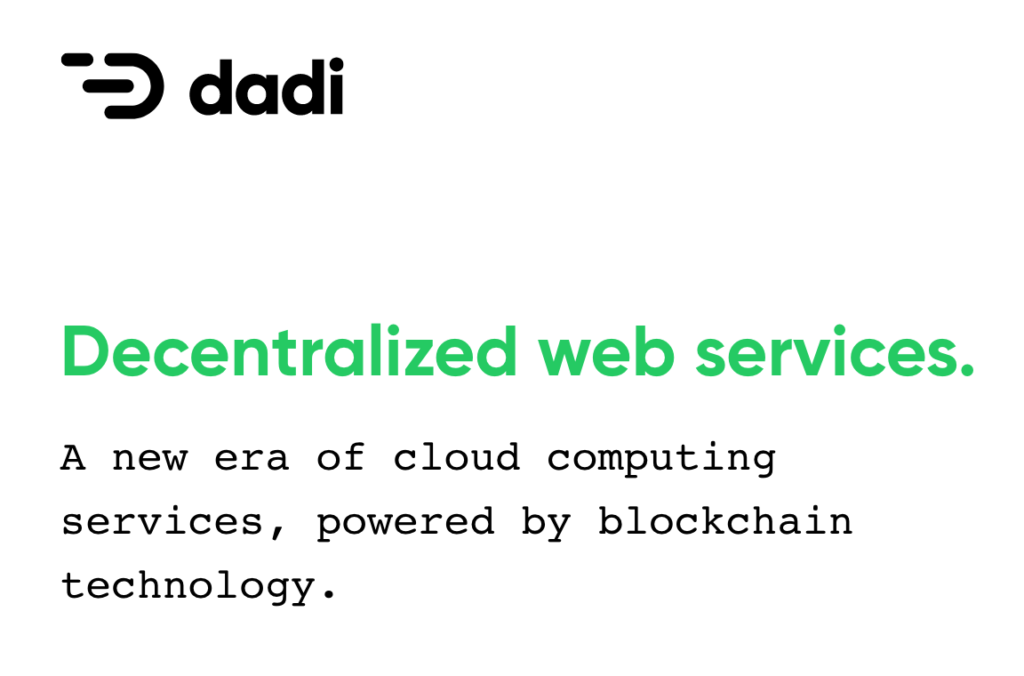
What are web computing services exactly? Who are the leaders of web computing currently in the market? Can these services be improved or completely redesigned for the better?
These questions and much more will be answered right away. But before I need to put a disclaimer that is mandatory for bloggers that write about crypto investing.
DISCLAIMER:
I do not provide personal investment advice and I am not a qualified licensed investment advisor. I am an amateur investor.
All information found here, including any ideas, opinions, views, predictions, forecasts, commentaries, or suggestions, expressed or implied herein, are for informational, entertainment or educational purposes only and should not be construed as personal investment advice.
Ok! Let’s continue!
I will start by talking about cloud/web services in general, then move to the Dadi concept of web services and why it is revolutionary. I will also talk about its real-life uses, the features and their current status.
In the next section I will talk about the specific services that will be sold and the ability to become a “miner” for the Dadi network. Finally I will highlight the key points in their whitepaper, github repo, marketing strategy and their team.
In the last section I will focus on talking about the Dadi crowdsale which is starting in January 22nd, 2018. The capping, token value, allocations, roadmap and how to participate will be discussed also.
Let’s now dive into the topic from the start and learn about a disruptive cloud computing service that might power the internet of the future.
Web/Cloud Services
What are web services exactly?
Web services are sometimes also called application services. Imagine that a developer wants to build a cool application, he will do it on his local computer because he can simulate a web environment and build the whole product start to finish with code running locally. After he builds that application he will not just keep it inside his computer isolated from the world, he will want to put it online, right?
To accomplish this the developer will use specific kinds of Web Services to take the application software he has written, and push it to the web, where now thousands of people can access it and interact with it.
The major cloud providers are currently AWS (Amazon Web Services), Microsoft Azure, Google Cloud, DigitalOcean, RackSpace and many more. The first three own the biggest share of the market.
The concept of cloud computing is very powerful, you no longer have to own a physical web server anymore and you outsource complex tasks such as security, reliability and maintenance to the cloud computing provider. Costs are also reduced because you only pay dynamically the provider for the resources you use.
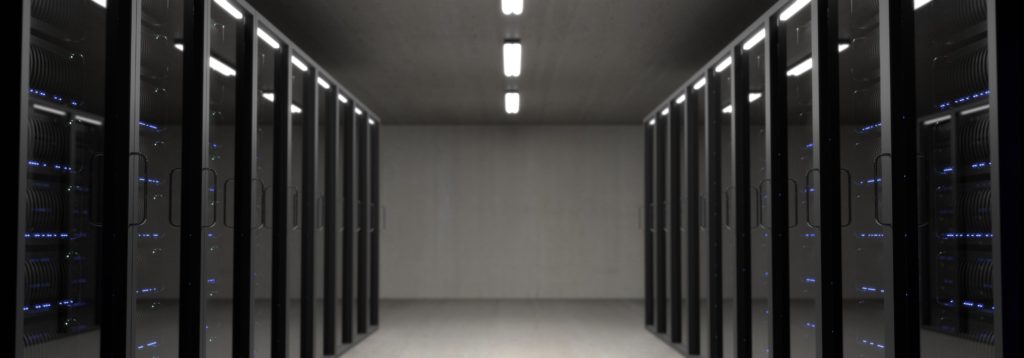
The only problems with current web services are mostly due to their centralized nature. In March of 2017 the datacenters of AWS, the most popular cloud computing provider, experienced technical problems and caused prolonged major outages for all the websites and apps that relied on their infrastructure. There is one central point of authority, and if it fails for some reason, it will bring down the rest of the infrastructure.
Another big issue is that you do not know what happens 100% with your data, if you might have backdoors on your cloud rented servers, or if some logs are kept permanently by the provider. The cloud provider will keep their infrastructure always private and their code NOT open source.
What if the blockchain design pattern can be applied to the area of web services? Can a decentralized and fair system that is not vulnerable to attacks be created? Can there be a way to see the source code powering the service you just rented?
This is exactly what Dadi is doing with its Blockchain-based web services. They are motivated to become the key players of a new era of cloud computing services.
Dadi’s goal is to be able to provision the best web services to developers that are building, scaling or growing their digital products. Dadi can be used for content & publishing platforms, content manipulation and distribution, mobile/tablet apps, critical services that need to be always-on, subscription services, cost-sensitive products, content classification, customer relationship management (CRM), ecommerce, machine learning based user experiences and big data.
The Dadi platform is built on top of the Ethereum blockchain, and therefore is regulated by autonomous, decentralized smart contracts which together form a DAO (Decentralized Autonomous Organization). The DAO uses fog computing, a highly cost-efficient way to regulate computing resource distribution.
Every app or digital product is powered by cloud services, so any business will be able to build their products on the Dadi infrastructure for a drastically cheaper price compared to traditional and centralized providers. The amazing thing about Dadi is that it also allows any internet user to rent their unused computational resources to Dadi’s network and generate passive income.
Their strongest motivation is to bring the Web to its original status of democracy.
If you are a technical person or a developer you can appreciate the inner architecture of Dadi, it consists of six major components: smart contracts as a transparency and consensus system, fog computing as a decentralized cloud computing model, protocol buffers for data serialization and network speed, Docker to create secure isolated environments, GRPC to distribute procedures across many hosts, Zookeeper for node communication and synchronization.
The best thing about this project is that they already have clients! In fact companies like the WhatCar.com magazine are currently using Dadi for their infrastructure, and by switching to Dadi they are saving 65% on their month-to-month costs!
Other success stories of Dadi include Monocle.com , Empireonline.com and even Virgin Limited Edition (virginlimitededition.com). They all display stunning websites rich in content and with very smooth interfaces.

It is stunning to see that blockchain-based web services from Dadi are powering all that content. While many ICOs don’t even have a prototype out, these guys have production-level infrastructure deployed already for these heavy-traffic and popular websites.
More about Dadi
What kind of web services is Dadi offering right now to paying customers? What other services will be offered next?
The cloud services that are currently available are Api, a high-performance api layer for software building, Publish, a service to optimize editorial workflow, cdn, a media/content delivery layer for the frontend of apps, Web, a templating layer to build apps with or without apis and Queue, a lightweight asynchronous task queue powered by redis.
The services that will be offered next are exciting and include Track, which provides accurate metrics, Identity, which deals with uniqueness of users/visitors, Match, a framework for automated content classification, Predict, a machine learning layer to predict user behavior, and Store, a cloud storage solution.
The only feature that does not have a planned release is Visualize, which is a data visualization interface that plugs into Identity and Track, but is also able to get data from any type of source.
An interesting chance that Dadi gives to any internet user is the ability to become a miner in the Dadi network. If you have any spare computational power, with Dadi you are able to “rent it out” to the Dadi decentralized ecosystem, and get income for that.
You can be one of the three types of miner: the Host, the Getaway or the Stargate. A stargate is only suggested for data center owners/operators, and the Dadi team needs to perform installations themselves. The getaway is best for whoever has primarily a high bandwidth availability, since they handle network negotiation and provide edge caching for Host-processed content. The last type of miner is the host, which is doable by anyone because it simply contributes pure computational power to the Dadi network.
Let’s now talk about the whitepaper, which since it’s over 70 pages long, cannot be summarized in a blog article, but can be checked out after on the Dadi website. The whitepaper content is very deep and Dadi includes a lot of screenshots of the dashboards, code snippets and detailed schematics about the project. I love the image they put at page 35 that shows a simple overview of the architecture.

Their Github page is very well organized. The main code repos to watch are api, publish, cdn and web. For each repo thousands of code commits have been written and there are major contributors that keep working on the code on a regular basis. Their Readme.md file is also well written with plenty of instructions to get started and understand the codebase. It’s literally one of the most complete and active Github pages I’ve ever seen for an ICO, it reflects the fact that their codebase is actively being used in real client projects.
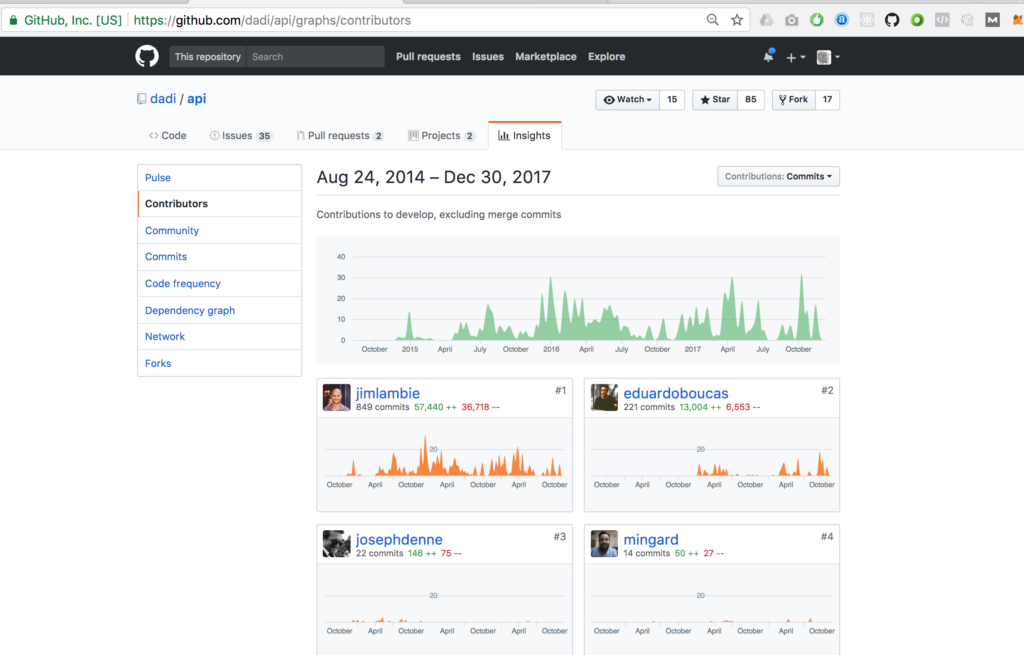
I like how Dadi mentioned as their marketing strategy that they will focus on developer-driven growth strategy. Since the product is very well engineered and functional, they know that by onboarding developers there will be a snowball effect. This because if one developer is happy to use Dadi, he or she will teach it to other developers who in turn will teach it to other developers, and so on.
What about the team behind Dadi? The team is full time committed to the project, has invested $2 million USD into it and it has been developing it for four years. It’s cool to see that the majority of the teammates are engineers and developers.
Another pleasant thing to note is that the Dadi team is very active in the community. On their website there is a list of events that they will attend. Participation in the community is definitely a factor that differentiates top ICOs from scammy ones.
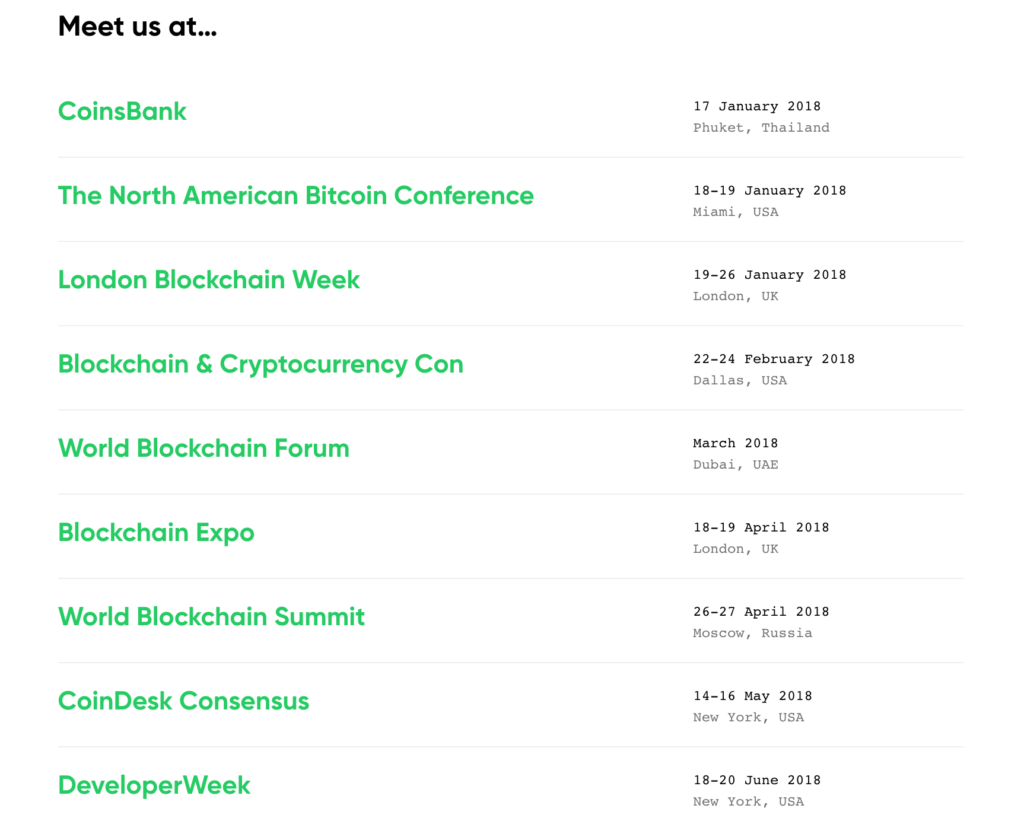
The roadmap that the team set for the future is very ambitious, and I think that on the long run they will have a chance to compete with the current big cloud providers. The 2017 goals have been accomplished and built on time. The next set of achievements planned for the Q1 of 2018 are a series of alpha releases of new services.
The Dadi ICO ($$$)
Dadi is now ready to go to the next level, or if you are a veteran of the crypto industry you will prefer another expression: Dadi is now ready to go to the mooooon. So they are having an ICO/crowdsale as a mean of getting more capital in order to grow their company faster.
Their ICO is going to be capped at $29 million USD, and it will start on January 22nd. The ICO will start with a short presale period, followed by a public sale.
When you contribute your ether to the Dadi ICO you will receive in exchange DADI tokens. These tokens are at the core of the platform, and they are used by consumers to obtain web services. The DADI token is built on the Ethereum blockchain and it follows the ERC20 token standard design, which means you will be able to conveniently store it on your MyEtherWallet or other ERC20-compatible wallets.
The total DADI token supply will be: 100,000,000. In the ICO period roughly half of them will be given to contributors.
The presale will start on January 22nd 2018, and 10,000,000 DADI tokens will be sold for $0.40 USD. The public sale will follow right after on January 29th 2018 (or earlier if the presale reaches their 10 million USD cap fast), and 50,000,000 DADI tokens will be sold for $0.50 USD. The token allocation is fair and the majority goes to the investors and to the founding team. A part of the allocation is also kept for referrals, meaning you can earn extra tokens by referring your friends and colleagues to Dadi’s ICO.
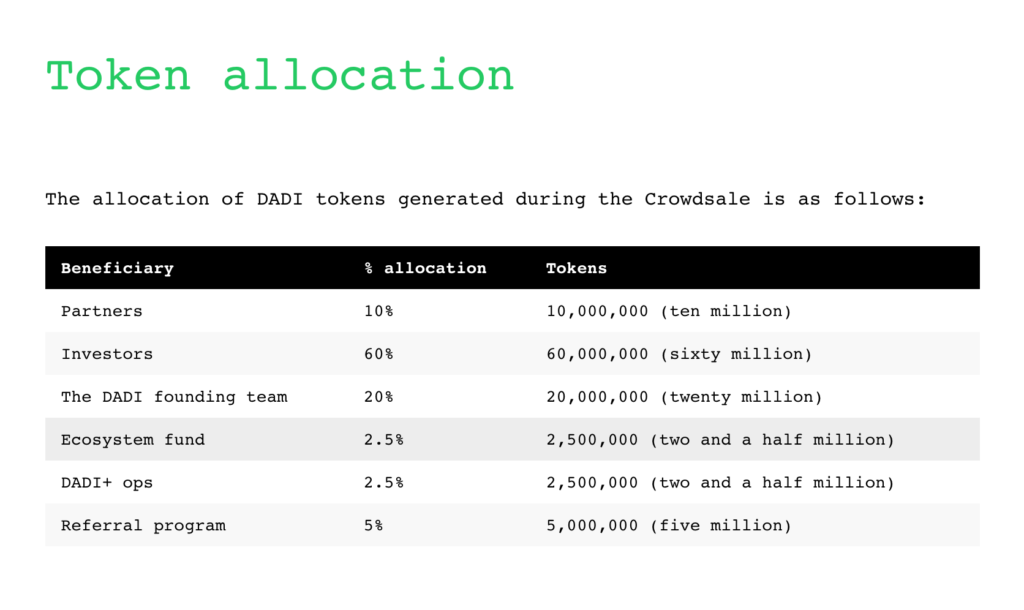
To participate in the ICO you need to have an Ether wallet ready that also accepts Ethereum-based tokens. When the ICO officially starts there will be an ethereum smart contract ready to accept ether contributions and give back DADI tokens at the specified rate. The public sale will finish either after 30 days of the start, or when the hard cap ($29 million USD) is reached. Given the importance and value of the project don’t assume the crowdsale will be open for long because they might reach the cap in a very short time.
Don’t miss the opportunity to get into one of the most exciting blockchain projects! Click here to make an account with Dadi and reserve a spot now in the ICO. The DADI tokens that you will buy during the ICO will probably be valued at much higher prices as soon as they are added to exchanges such as binance, cryptopia or HitBTC. In these exchanges or more, you will be able to cash out all or some of your tokens for profits, depending on your ICO investment strategy.
Conclusion
In conclusion, I had a lot of fun learning about this disruptive cloud services company. A lot of things such as the Github repo amazed me and made me realize that this project deserved a whole article about it.
This is the kind of project that we need right now in the crypto ecosystem, a set of solid functional technologies that will slowly substitute traditional centralized services with decentralized ones.
I kept this article non-technical so you can understand the project on a macro level, and have a strong foundation to go into the Dadi website yourself and dig deeper on whatever you feel like learning.
What do you think about Dadi? Will you support the project and become a contributor? Feel free to post a comment also if you did not understand something.
